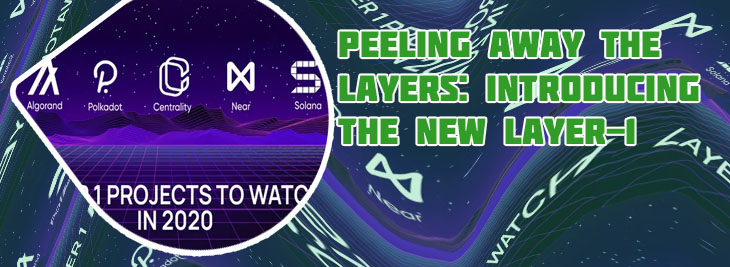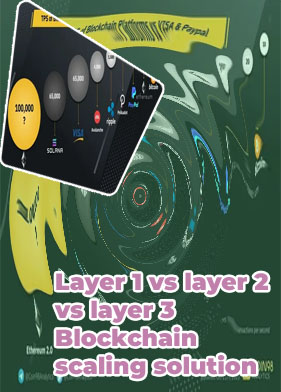Layer 1 crypto

Key differences between Layer 1, Layer 2, and Layer 3
The new layer-1 and layer-2 landscape has evolved to tackle scalability. We introduce new layer-1 technologies, optimistic and zero-knowledge (ZK) rollups, the Blockchain Trilemma, and more. Layer 1 crypto projects Justin Sun highlighted the decentralized nature of TRON as a blockchain protocol comparable to the…What is l1 crypto
Zero-knowledge solutions grant developers a way to leverage the security of an existing layer-1 blockchain like Ethereum while enabling dApps to scale through higher throughput and faster transactions, protecting users’ personal information by keeping it hidden off-chain, and lowering the cost for end-users by publishing transactions in batches. Ultimately these advantages enable projects to build advanced dApps that rival the performance and functionality of Web2 systems while maintaining the benefits of decentralization. Bytecoin BCN The Total Value Locked (TVL) on Ethereum reached 23,887 billion US dollars. Of all the dApps on Ethereum, Lido controls the TVL with almost 17 billion US dollars or 70.89% of the total. Lido is a liquid staking platform for several crypto assets.
2. How does a Layer 1 crypto project differ from Layer 2?
With continued increases in network demand, blockchain networks will rely on scaling solutions such as Layer 1 and Layer 2 to provide stable and efficient transaction handling in the future. Recommended for you: The story of Bitcoin begins in 2009 when an enigmatic figure or group using the pseudonym “Satoshi Nakamoto” introduced this revolutionary digital currency to the world. Satoshi Nakamoto’s true identity remains shrouded in mystery, adding to the intrigue surrounding Bitcoin’s origins. Still, the creation of Bitcoin marked a watershed moment in the history of electronic money and laid the groundwork for the burgeoning cryptocurrency market.What is l1 crypto
Layer 1 projects are blockchains. Public blockchains are digital ledgers designed to easily read or add financial data and prevent changing the existing one. Each blockchain has a different consensus model to agree on what data to add, along with smart contracts to automate transactions without third-party intervention. Unlike applications, smart contracts are autonomous programs that don’t interact with users directly. Some smart contracts, like Bitcoin’s, only allow basic payments, while others, like Ethereum’s, allow developers to create complex applications. What are DeFi flash loans? DeFi lending explained Solana’s DeFi ecosystem is experiencing a recovery period after the turmoil caused by the fall of crypto exchange FTX. Many new protocols are emerging in Solana, offering various DeFi services such as DEX, lending protocol, etc.
Bitcoin faucetsOpulous cryptoOxen cryptoCryptoBitcoin account setupBitcoin stakingBitcoin 10 year chartSos cryptoEth feesBitcoin peer to peerInvesting in bitcoinVechain cryptoDownload cryptocom appBitcoin hash rateStrong cryptoCoinbase crypto listBinance bitcoin dropMetaverse coins on cryptocomHex cryptoCrypto com stock symbolHow long does bitcoin take to sendBest tools for crypto tradingLaunches its cryptocurrency uk
- How to transfer money from cryptocom to bank account
- Btc mining
- Cryptocom payment methods
- Bitcoin cryptocurrency
- Crypto announcements
- Free btc mining
- Billionaires embrace cryptocurrencies money goes hell
- Apps cryptocurrency
- Paypal btc wallet
- Safemoon crypto com
- Launches crypto world check section blog
- Cryptocom verification process
- Top 20 cryptocurrency
- Crypto com not working
- Kasta crypto price
- Dogecoin graph
- Crypto com nft
- How does btc mining work
- Buy bitcoin cash
- Can you buy crypto with a credit card
- Crypto credit card
- How much to buy dogecoin
- Bitcoin starting price
- Bitcoin futures
- Should i buy doge or ethereum
- Bitcoin chart live
- Buy crypto with credit card
- Btc address lookup
- Cryptocurrency prices
- Top cryptos
- Saitama crypto where to buy
- Bitcoin price usd prediction
- Buy doge with btc
- Cryptocom price
- Btt crypto price
- Usd to eth
- Litecoin historical price
- Bitcoincom exchange
- How many btc are there
- Ethusd price
- How to buy dogecoin on trust wallet
- Where can i buy bitcoins near me
- Cryptocom dogecoin
- Cryptocurrency exchanges
- Usd crypto
- How to spend bitcoin
- Coinbase cryptocurrency prices
- Crypto november
- What the hell is bitcoin
- Where to buy bitcoin
- Strong crypto
- Solana crypto price
- Crypto wallet app
- Bitcoin price cad
- How much is 1eth
- Binance bitcoin
- How does bit coin work
- Ethusd converter
- Will dogecoin be on coinbase
- Cryptocurrency bitcoin price
- Doge crypto
- Dogecoin converter
Email Us
